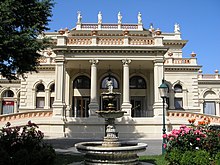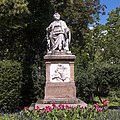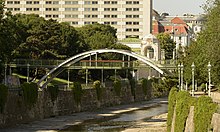Vienna City Park

The Wiener Stadtpark stretches from the Parkring in the 1st district of Vienna to the Heumarkt in the 3rd district of Vienna and is a popular Viennese park with tourists as well as local residents . Its area is 65,000 m².
history

The water glacis in front of the Karolinenstadttor was already a popular entertainment venue in the Biedermeier period . In the course of the redevelopment into the Vienna Ringstrasse , which resulted from the demolition of the Vienna city wall , the then Mayor of Vienna Andreas Zelinka supported the project of a public park on this site. In September 1860, the city expansion fund gave the City of Vienna free of charge an area of 94,000 m² for the construction of the city park; In 1861, 51,000 m² were added on the right bank of the Wien River. For the design of the park on the left bank, the cost estimate was 115,000 guilders; In fact, in 1862 it was 180,000 guilders (approx. 1.6 million euros).
This park was planned in the style of an English landscape park by the landscape painter Joseph Sellény , the planning was revised and carried out by the city gardener Rudolph Siebeck . On August 21, 1862, the northern part of the city park was opened, including the Park Salon , a refreshment facility owned by coffee maker Heinrich Wilda (1821–1903) and offering space for 300 guests . According to other sources, large parts of the city park were open to the public from August 1862 - without an official opening. The city park was the second city park in Vienna after the no longer existing Franz-Josefs-Park on Franz-Josefs-Kai .
The so-called children's park was built on the right bank of the Vienna River in 1863, today mainly characterized by asphalt playgrounds and sports facilities, which is connected to the city park on the left bank via the Stadtparksteg. From the winter of 1867/68 onwards, the pond in the park was converted into an ice rink every year, which could be used for an entry fee of 30 kroner. Since many working people could only skate in the evening, electric lighting was installed in 1870. In 1871 the ice rink was given to the leaseholder of the Kursalon.
In the years 1903 to 1907, following the regulation, a Vienna river barriers planned by Friedrich Ohmann and Josef Hackhofer with the river portal, pavilions and bank stairs were built, which is one of the sights in the park.
In earlier times, visitors to the park had to pay fees for lounging in armchairs, which were collected by the so-called chair women . This visitor service, run by a private company, ended in 1956.
Sellenygasse in the 2nd district of Leopoldstadt has been a reminder of the park's designers since 1891 and Siebeckstraße in the 22nd district of Donaustadt since 1960 .
Landmarks in the park
Kursalon
At the water glacis there was a spa pavilion in which medicinal water for drinking cures was served. Accordingly, the Kursalon was built for the city park between 1865 and 1867 according to plans by Johann Garben and opened on May 8, 1867. The Park Salon Heinrich Wilda (see above), a timbered Glass Pavilion , was closed after four and a half years of operation, with May 8, 1867, and (unsuccessfully) offered with the inventory as sales; It was not until February 1869 that the local council decided to exchange the former Salon Wilda for 25 cubic fathoms (89.9 m³) paving stones by auction. Wilda, who ran a café next to the children's park at Heumarkt 15, had applied for the lease of the Kursalon, but was subject to competitors Johann Hembsch (formerly Wasserglacis) and Johann Mayer (Café Asperngasse 1) in the bidding process .
The splendid historical building in the style of the Italian Renaissance is located on Johannesgasse and has a wide terrace into the park. At the time of the Strauss brothers , the Kursalon was a popular dance and concert venue; today, after a renovation phase, it is once again a venue for balls, concerts, clubbing and congresses, and it also houses a café-restaurant.
Monuments
With the gilded bronze statue of Johann Strauss (son) stands one of the most famous and most photographed monuments in Vienna in the city park. It comes from Edmund Hellmer , was unveiled on June 26, 1921 and is framed by a marble relief (see main article Johann Strauss Monument ) .
There are other monuments, for example, by Franz Schubert , Franz Lehár , Robert Stolz , Hans Makart , Sebastian Kneipp and Anton Bruckner ; the city park is Vienna's richest park in monuments and sculptures.
Metro station
The Stadtpark underground station is in the south of the park and is served by the U4 line. It was opened on June 30th, 1899 as part of the Wientallinie of the Viennese light rail system designed by Otto Wagner .
Another underground station is in the north of the city park, the Stubentor station .
bridges
In the Stadtpark, two bridges cross the Wien River and connect the north-western and south-eastern parts of the city park. The Stadtparksteg is located right next to the underground station , and a little further down the river is the Little Hungarian Bridge .
Well systems
A total of six fountains were built in the city park. Three of them are located in the main part in the 1st district (the Liberation-der-Quelle-Brunnen , the Donauweibchenbrunnen and the Vogeltränkebrunnen ). In the so-called children's park in the 3rd district there are the Kneipp fountain, the refreshment fountain and the basilisk fountain.
Dairy farm
The former milk drinking hall was built between 1901 and 1903 as part of the Vienna river construction according to plans by Friedrich Ohmann and Josef Hackhofer . Badly damaged during the Second World War , the building was then restored in a very simplified manner. In 2004 the dairy was torn down to the ground and rebuilt as a restaurant. Only the crowning of the mansard roof dates from 1903.
From 2002 to 2005 the building was expanded. Heinz Reitbauer has been cooking here ever since .
In 2014 the terrace area of the Steirereck restaurant was replaced by a polygonal mirrored pavilion .
City Garden Directorate
On the border of the children's park with Johannesgasse and Am Heumarkt, the management building of the municipal garden authority, designed by Josef Bittner (1879–1945), was built between 1906 and 1907 . During the renovation carried out around 1990, it got its wall trellises and the pergola back, which, however, were re-glazed for reasons of space utilization.
planting
The planting of the city park is characterized by a great diversity of species and is geared towards year-round flowering. Noise and exhaust gases are filtered through an avenue leading to the Ringstrasse. Some trees are under nature protection , such as a ginkgo , a Christ thorn , a pyramid poplar and a Caucasian wingnut .
Enjoyment festival
Since 2008, the Gourmet Festival has been held every year on Mother's Day weekend in early May in the city park. In more than 170 tents, manufacturers from the nine federal states present regional products that can be bought and also tasted at many stands. The festival is organized by the City of Vienna and the Austrian Culinary Heritage Association .
literature
-
City Garden Directorate in Vienna. Designed by the Vienna City Building Authority. In: Wiener Bauindustrie-Zeitung , year 1908, volume I., No. 12/1907, December 20, 1907 (XXV. Year), p. 102 f. (Bulk). (Online at ANNO ). .
- City Garden Directorate in Vienna. In: Wiener Bauten-Album , year 1908, volume I., No. 12/1907, December 20, 1907 (XXV. Year), p. 23 f. (Plans). (Online at ANNO ). .
- (Georg) Haussmann: The city park of Vienna including the Kursalon and reserve garden. In: Allgemeine Bauzeitung , year 1872, (XXXVII. Year), p. 325 ff. (Main part). (Online at ANNO ). .
- -: City park and reserve garden in Vienna. In: Allgemeine Bauzeitung , year 1872, (XXXVII. Year), pp. 49–55 (plans). (Online at ANNO ). .
- Eva Berger : Historic Gardens of Austria. Gardens and parks from the Renaissance to around 1930 . Volume 3: Vienna . Böhlau, Vienna (inter alia) 2004, ISBN 3-205-99353-5 , pp. 89–91 and pp. 138–140.
- Eva Berger: City Park and Children's Park . In: Christian Hlavac, Astrid Göttche, Eva Berger (all eds.): Historical gardens and parks in Austria . Böhlau, Vienna 2012, ISBN 978-3-205-78795-2 , pp. 295-301.
- Christian Hlavac: The Vienna City Park. The oldest city park in Austria is celebrating its 150th anniversary . In: Stadt + Grün. The garden authority. Organ of the permanent conference of the horticultural department heads at the German Association of Cities . No. 10/2012. Patzer, Berlin 2012, ISSN 0948-9770 pp. 51-55.
- Eva Berger, Christian Hlavac: 150 years of the Vienna City Park - what has been preserved and what has disappeared . In: Denkma (i) l. News from the Monument Protection Initiative . No. 13, February – May 2013, ZDB -ID 2639479-0 , p. 32 f. - Online (PDF; 9.1 MB) .
Web links
Individual evidence
-
^ Wiener Nachrichten. 20th of August. (...) The opening of the park salon (...). In: Die Presse , No. 230/1862 (15th year), August 21, 1862, p. 4, center right. (Online at ANNO ). ;
Vienna City Gardens (Red.): City Park. (...) History of the city park . In: wien.gv.at , accessed on May 25, 2015. - ^ Christian Hlavac: The Vienna City Park. The oldest city park in Austria is celebrating its 150th anniversary . In: Stadt + Grün. The garden authority. Organ of the permanent conference of the horticultural department heads at the German Association of Cities . No. 10/2012, ZDB -ID 2374851-5 , p. 51-.
- ↑ Kurt Mollik, Hermann Reining, Rudolf Wurzer: Planning and Realization of the Vienna Ring Road Zone . Franz Steiner Verlag, Wiesbaden, 1980. ISBN 3-515-02481-6 . (Volume III by Renate Wagner-Rieger (ed.): The Vienna Ringstrasse. Picture of an Era. (Volume I - XI) . Franz Steiner Verlag, Wiesbaden, 1972–1981. ISBN 978-3-515-02482-2 )
- ^ Vienna in retrospect - July 3, 1956: In the urban parks: chair use without payment
- ↑ (activation :) Cur-Salon in the city park. In: Fremd -Blatt , Abend-Blatt, No. 125/1867 (XXI. Year), May 8, 1867, p. 7 (unpaginated), top right. (Online at ANNO ). .
- ↑ (activation :) Stadtpark. In: Fremd -Blatt , Abend-Blatt, No. 125/1867 (XXI. Year), May 8, 1867, p. 9 (unpaginated), top right (Online at ANNO ). .
- ↑ From the municipal council. In: Wiener Zeitung , No. 35/1869, February 13, 1869, p. 481, center left. (Online at ANNO ). .
- ^ Vienna City Council. Meeting of April 24th. In: Local-Anzeiger der "Presse" , supplement to No. 12/1867 (XXth year), April 25, 1867, p. 10 (unpaginated), bottom center. (Online at ANNO ). .
- ↑ a b Eva Berger, Christian Hlavac: 150 Years of the Wiener Stadtpark - Preserved and Disappeared , p. 33.
- ↑ architektbrenner.com: Steirereck
- ↑ falstaff.at: Bachls Restaurant of the Week: »Steirereck in the City Park«
- ↑ ppag.at: Steirereck
- ↑ Genuss-Festival 2014 at www.kulinarisches-erbe.at, accessed on May 16, 2014
Remarks
- ↑ Father of the genre painters Charles (1854–1907) and Gottfried Wilda (1862–1922). - See: Felix Czeike : Wildagasse . In: wien.gv.at/wiki/ , February 21, 2015, accessed on May 25, 2015.
- ↑ In economic terms, Wilda relied on the close proximity of the Kurhaus, which he was not allowed to lease, and on his regular guests acquired in the former city park: on November 11th of that year he opened just a good 100 meters further at Kolowratring 2 (today: Schubertring 2) by architect Julius Stepwieser (1835–1883) Ringstrasse café furnished in French style. - See: (activation :) Heinrich Wilda's coffee house opening. (...). In: Wiener Zeitung , No. 267/1867, November 10, 1867, p. 519, bottom right, (online at ANNO ). and General Information Bureau. (…) No. 4. Café Wilda again. In: Hans Jörgel von Gumpoldskirchen , No. 48/1867 (XXXVIth year), November 23, 1867, p. 6, top right. (Online at ANNO ). . - On February 27, 1869, settlement proceedings were opened against Wilda's property ; In August of that year, coffee maker Karl Ostermayer took over the Ringstrasse café Wildas, who was sentenced to 14 days in prison on September 29, 1869 for careless crime .
Coordinates: 48 ° 12 ′ 17 " N , 16 ° 22 ′ 50" E



















